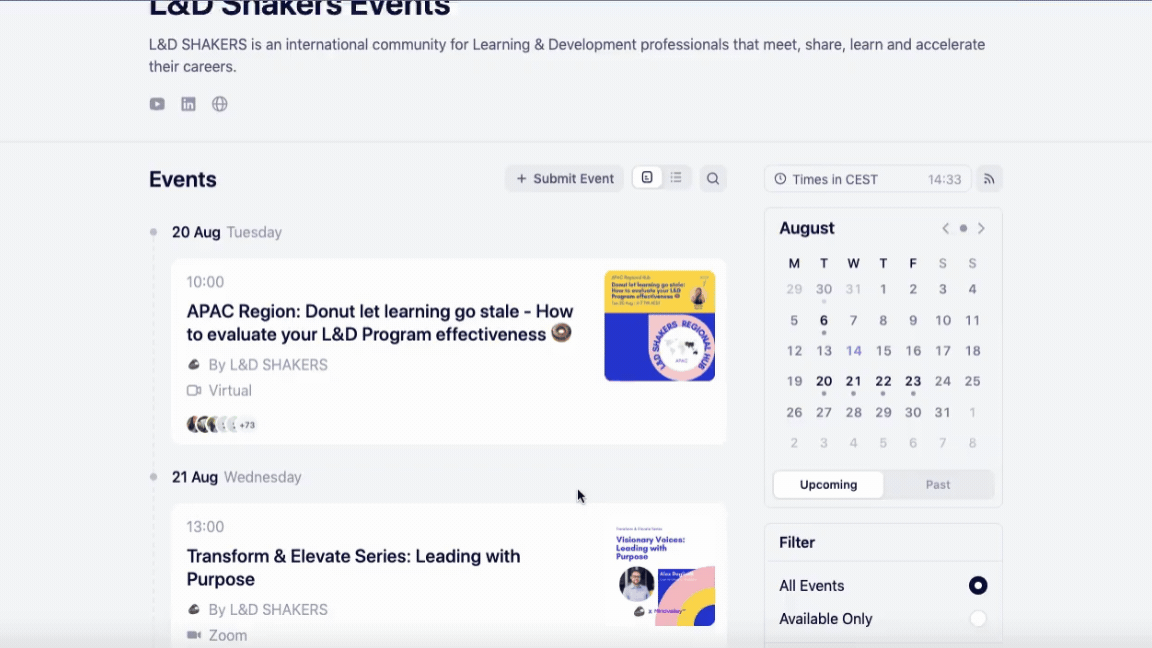TLB #36🧠 Why Context matters more than you think
A bi-weekly inside scoop on all the hottest events, juicy discussions, and oh-so-many other exciting things happening in our dynamic L&D community. 🧡
Hello Shaker,
Here’s all that you’ll experience in today’s issue:
💡Learning Bites: Context in L&D
🗓️ Community Calendar: Be a part of Donut let learning go stale - How to evaluate your L&D Program effectiveness and many more cool events.
🔖 Resource Reel: A collection of resources on Distributed Leadership, innovation and many more.
🎤 Shaker's Stage: This week’s stage is taken by Sobia Kiran.
Learning Bites 💡
Picture this: A global corporation that recently implemented a leadership training program across its diverse regional offices. The content is robust, the facilitators are top-notch, and the resources are abundant. Within weeks, feedback from employees pours in—participation drops and the program’s impact is negligible, the feedback is lukewarm at best. The program, despite all its strengths, seems to miss the mark.
What went wrong? The answer lies in a crucial but often overlooked factor: Context. The scenario above is all too common in the world of L&D. So, how can we avoid these pitfalls and ensure our initiatives succeed? The key is understanding and integrating Context at every level.
Human behavior is influenced not just by individual traits or characteristics, but also by the social, cultural, and physical contexts in which it takes place. In L&D, "Context" refers to the various factors that shape the design, delivery, and effectiveness of learning programs. This includes business objectives, organizational culture, technological infrastructure, and the unique needs of learners. By deeply understanding these contextual elements, L&D professionals can create programs that resonate, engage, and drive meaningful outcomes.
As we dive deeper, let’s explore the specific contexts that L&D professionals need to be aware of to incorporate into their strategies and some of the best practices as L&D professionals that you can adopt to know the Context.
1. Context in Business Alignment
Aligning L&D strategies with business goals requires a deep understanding of the company's strategic direction, market challenges, and internal dynamics.
For example, Microsoft’s L&D team offering AI Skills, a learning pathway for staying ahead of emerging skills gaps and succeeding in a rapidly changing economy ensuring that not only their employees but everyone gets resources to be prepared to support the new business models.
Best Practices:
—Contextual Analysis: Regularly assess the business environment, including market trends and competitive pressures, to ensure L&D initiatives are relevant.
—Executive Collaboration: Engage with business leaders to understand their vision and objectives, and tailor L&D strategies to support these goals.
—Agile Adjustments: Be prepared to pivot L&D initiatives as business priorities shift, using data-driven insights to guide decisions.
2. Context in L&D Strategy
L&D strategies must align with the organization's culture and values. For instance, Google’s culture of innovation is reflected in its L&D programs, which encourage creativity and experimentation. In contrast, a more traditional organization might prioritize compliance and consistency in its training programs.
For example, Google founders in their 2004 IPO letter wrote, we encourage employees to spend 20% of their time working on what they think will most benefit Google. This empowers them to be more creative and innovative. Many of our significant advances have happened in this manner. Read more about it here: How Google's Innovative Training and Development Programs Empower Employees
Organizational change, whether due to technological advancements, mergers, restructuring, or market shifts, requires an adaptable L&D strategy. By guiding employees through the process of understanding new contexts, L&D can facilitate smoother transitions and better alignment with new business realities.
Best Practices:
—Cultural Sensitivity: Align L&D initiatives with the organization’s culture to ensure they resonate with employees and reinforce company values.
—Change Readiness: Integrate change management principles into L&D strategies, preparing employees to adapt to new contexts effectively.
—Adaptive Strategies: Continuously evaluate and adjust L&D strategies to remain aligned with evolving business needs.
3. Context in Program Design
Effective program design considers the learner's context, including their roles, experience levels, and learning preferences.
For example, AT&T’s Future Ready program, aligns learning modules with specific job roles, ensuring that employees can immediately apply what they learn to their work. Read more about it here: Reskilling: A response to the war for talent
Best Practices:
—Personalized Learning: Use learner profiles to tailor content to individual needs, enhancing relevance and engagement.
—Cultural Competence: Ensure that programs are culturally sensitive and inclusive, particularly in global organizations.
—Tech-Enabled Learning: Leverage technology to provide flexible, accessible learning experiences that meet learners where they are.
4. Context for Learners
Contextual learning that is directly tied to real-world tasks improves engagement and retention. AT&T’s approach which we talked about above of aligning training content with specific job roles is a model of how to make learning immediately applicable and valuable. Personalized learning paths, which consider each learner’s career goals, experience, and learning style, lead to more effective outcomes. Whether learners are remote or on-site, the environment plays a crucial role in their ability to absorb and apply new knowledge.
Best Practices:
—Job-Relevant Content: Ensure that learning content is directly applicable to learners’ daily tasks and responsibilities.
—Adaptive Learning Technologies: Use adaptive technologies to create personalized learning experiences that align with individual learner needs.
—Supportive Environments: Create learning environments, whether virtual or physical, that support engagement, collaboration, and knowledge retention.
That’s all Shakers! This week as you plan your next L&D initiative, take time to map out the relevant contexts.
—How well do you understand the business’s strategic goals?
—Have you considered the unique needs and challenges of your learners?
—Are your programs culturally sensitive and technologically accessible?
By asking these questions, you can ensure your L&D efforts are aligned with both organizational objectives and learner needs.
Coming Up Next
Community Calendar 🗓️
Our upcoming events are just around the corner, designed to inspire and inform. Make sure you're on the list—register using the link given below!
Cool Stuff You Don’t Wanna Miss Out
Resource Reel 🔖
This week’s hottest resources are:
How “distributed leadership” can help all companies navigate transformation by Big Think talks about creating a culture of “in-role CEOs” — and moving from “command and control” to enablement in today’s corporate landscape which is changing rapidly.
Hype Cycle for Innovation Practices, 2024 by Gartner lists out various innovation practices in the Hype Cycle to identify the innovation practices that are most likely to deliver success in all stages of the innovation process.
ENGAGE Report 2024 by Go1 talks about the state of L&D budgets and their spending power, L&D leaders’ top goals and aspirations for employees, the rise of AI in L&D and potential use cases, the most in-demand leadership, business, and technology skills and L&D teams’ preferred content lengths, formats, and languages.
Free Project Toolkit by Justin Bateh, PhD to help you streamline your processes, enhance your project management skills, or simply get organized, this toolkit is your go-to resource for immediate impact and long-term success.
A suite of Inclusive Communications toolkit by More Diverse Voices packed with 11 different guides and workbooks, all with practical exercises, resources and frameworks on inclusive communication including a communication strategy workbook, inclusive content calendar, how to write a thought leadership article and some more.
12 Top Facilitation Communities by SessionLab, if you are just starting or experienced, there is something for everyone who is facilitating packed full of generous people along with opportunities to learn, be inspired and practice.
The 4 Returns Framework in Practice by 4 Returns, a guidebook for holistic landscape restoration talks about Theory U in one of the chapters for creating spaces of belonging as the cornerstone for holistic and long-lasting change.
L&D Backstage by L&D Shakers, a YouTube playlist with recordings of some of the past sessions covering case studies from L&Ds showcasing a project they have been working on, giving us a realistic glimpse into their design and implementation process. Some of the studies that you’ll find are competency-based mastery from Ogury to building a leadership board game.
Community Corner:
Shaker's Stage 🎤
Let’s welcome Sobia Kiran, Professional Development Advisor at the University of Central Punjab to take the stage.
What’s a memory you hold very dear?
-My father dropping me off at the school bus stop. It was on the park side and he would put me on the other side of the fence. I would take a round of the park see some fish and come back meanwhile my bus would have also arrived and then I would go on the bus to school.
What’s the biggest challenge you’re facing in your role/business/project right now and how are you tackling it?
-The biggest challenge I'm currently facing is effectively managing timelines to meet both my professional and personal goals. Balancing work responsibilities with personal aspirations can be demanding, especially when deadlines and commitments overlap. To tackle this challenge, I've implemented the following strategies: Prioritization: I prioritize tasks based on urgency and importance, focusing on high-impact activities that align with my overarching goals. Time Blocking: I use time-blocking techniques to allocate specific time slots for work, personal development, and leisure activities. Effective Time Management: I utilize time management tools and techniques, such as the Pomodoro Technique or Eisenhower Matrix, to optimize productivity and minimize distractions. Flexibility and Adaptability: I remain flexible and adaptable in my approach, recognizing that unexpected challenges or opportunities may arise. Being open to adjustments and changes allows me to navigate unforeseen circumstances while staying on track towards my goals. By implementing these strategies, I aim to effectively manage timelines and strike a harmonious balance between my professional and personal goals, ultimately achieving success and fulfilment in both areas of my life.
What’s a source of inspiration for you right now?
-Currently, I find inspiration in individuals like Anamaria Dorgo, who admirably leads the L&D Shakers Club while effortlessly managing various tasks simultaneously. Witnessing her adeptness in juggling multiple responsibilities fuels my own motivation and drives me to excel in my endeavours.
What does being an L&D Shaker look and feel like for you?
-For me, being an L&D Shaker feels like embracing innovation, creativity, and a relentless drive for growth and development. It's about constantly challenging the status quo, pushing boundaries, and inspiring others to think differently about learning and development. It's a mindset of curiosity, adaptability, and a passion for continuous improvement. Being an L&D Shaker means being a catalyst for positive change, both within myself and in the organizations and individuals I support.
〜See you soon
Till then, keep spicing up your learning! 🧠🧂
Sejaal







